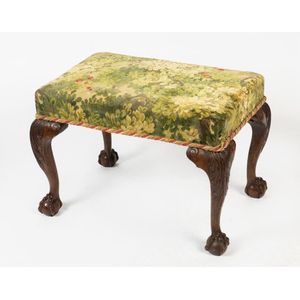Queen Anne Floral Brocade Upholstered Footstool with Carved Legs
A Queen Anne floral brocade upholstered footstool, 18th century, the stuffover seat upholstered in a verdure tapestry type fabric with a rope trim and raised on cabriole legs with relief carved acanthus knees and ball and claw feet, 46 cm high, 57 cm wide, 42 cm deep
You must be a subscriber, and be logged in to view price and dealer details.
Subscribe Now to view actual auction price for this item
When you subscribe, you have the option of setting the currency in which to display prices to $Au, $US, $NZ or Stg.
This item has been sold, and the description, image and price are for reference purposes only.
- Claw Feet - Carved or cast in the shape of a lion's claw or the talons of other more fabulous beasts. They may be found on chair and table legs, supporting platform bases, and cabinets in the Classical Revival manner. Claw feet are not uncommon on Australian furniture made throughout the 1850s and 1860s, though, as with all forms of carving, the deeper and richer the claws are carved, the earlier the piece is likely to be.
- Cabriole Leg - The cabriole leg evolved from an elongated scroll, curving out at the knee which may or may not be carved, and forming a serpentine shape as it descends to the foot.
First introduced into English furniture in the late 17th century, cabriole legs were widely used during the Queen Anne and early Georgian periods, where they frequently terminated in a pad foot or ball and claw foot. The style has had many imitators since then. The cabriole leg was re-introduced in the mid-19th century, and is commonly associated with the balloon-back dining or drawing-room chairs made in walnut, mahogany or, in Australia, cedar. The Victorian cabriole leg, on the whole, was rather more slender than the earlier form, following the French style, which emphasized the delicacy and daintiness of the chairs they were designed to support. Cabriole legs are sometimes found on windsor chairs, especially those made during the 18th century. - Ball and Claw Feet - Are in the shape of a rounded ball, attached to the underside of the carcase by a wooden shank. Introduced during the late 17th century and found on furniture in the William and Mary and Queen Anne style, are commonly found on cabriole legs in the manner of Thomas Chippendale, and furniture imitating the mid-18th century Rococo style. The leg terminates in a ball held by a carved lion's or bird's claw.
- Acanthus - A stylized leaf motif, one of the primary decorative elements of classical Greek and Roman architecture, derived from the genus of flowering plants in the family Acanthaceae, native to tropical and subtropical regions of the Mediterranean area. It is a common element in classical Greek and Roman design, and is often seen in Corinthian and Composite order columns and used as a decorative element in English, European and Australian furniture, particularly on the curve of a leg, and as decoration for a corbel.
This item has been included into following indexes:
- stools, period or age - Georgian 89
-
stools, type or function
- cabriole leg 67
- foot stools 180
- upholstered 338
